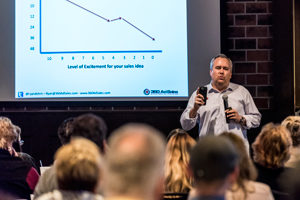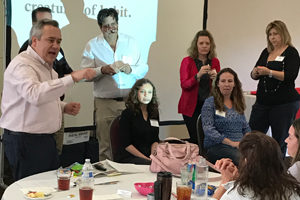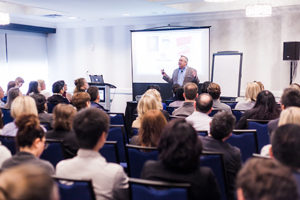7 Ways to Reignite Sales Conversations in a Post-COVID World
7 Ways to Reignite Sales Conversations in a Post-COVID World
The dramatic impact that the novel coronavirus has had on the United States and the world is undeniable. There are many different ways to view what has happened, and I do not wish to be political—I trust that everyone can handle politics in their own way.
For our sales conversations, though, I believe that we need to start getting back to business—whatever that means for your particular company as it relates to sales and marketing.
In that vein, let’s talk about seven ideas to help us get back to business from where we now stand. These are realizations I’m finding to work well for me in my own sales life, and that I’m sharing with others as part of my larger sales training efforts.
Idea 1: The time to get back to sales conversations is now.
There are a lot of people out there talking on the internet and social media about selling during COVID-19—and it was tough. I must reiterate: The conversations out there were tough. And now, at the time of this writing, we’re almost two months into this and the conversations are largely OK now. Maybe one out of 50 folks I’m calling on has been personally impacted or has had something happen in their families, and they’re not ready to talk. I get that. I totally get that.
It’s for those folks, when I get them on the phone, I just apologize, sympathize, and say, “Hey, when you’re ready to talk, I’m here.”
But one of the things I hear sales reps doing right now in my sales training (marketers, too) is starting every conversation with, “Hey, Bob. How are you doing?” And that’s just wrong.
Now, if you’ve known the person for a considerable period of time, then you might consider them a colleague and you might start the conversation that way.
But if you’re calling on a new prospect, and you don’t know them from anybody else, I think asking them about their personal health is not the best way to start the conversation.
In addition, everybody is starting the conversation that way. And unfortunately, it leads to a pretty negative start to a sales call.
So what I like to do is put a little different spin on it. I might say, “Hi, Bob. I’ve got some news to share with you—some good news, as a matter of fact. Would you have time for a new idea?”
Or, “Hey, Bob. I see some light at the end of the proverbial business tunnel, and I’d love to chat with you a little about some new ideas. What do you think?”
I think that’s a very appropriate way to start a sales conversation. In fact, I think it’s so important that I want to caution you again, when you start the conversation, “Hey, Bob. How’re doing?” you might get somebody who says back to you, “How the (blank) do you think I’m doing?” And again, I’m not at all saying that you shouldn’t sympathize. What I’m saying is that everybody is starting the conversation with, “Hey, how are you going?” and a lot of the time it leads to a pretty negative conversation and gets things off to a fairly negative start.
In the end, though, how you kick off the first conversation is up to you and to your personal preferences. For me, it was a bit tough to get past the “Hey, how are you doing?” It really was, and so I get that.
To recap, if you’ve had a relationship with somebody for years, it’s natural that you’ll want to ask them how they’re doing.
But otherwise, my advice is to always start the conversation with a bit more positive phrasing—to kick off a more positive conversation.
Idea 2: Recognize that a lot of people are still working from home.
Here’s what’s really interesting about COVID-19 on a positive side, if there is a positive side. And that’s that everybody pretty much knows how to do a GoToMeeting or a Zoom meeting. They’re comfortable with it and that makes it a little bit easier to sell that way.
We taught my mom how to run a Zoom meeting the other night. So c’mon, if I can teach my mom how to run a Zoom meeting, if you do happen to run across somebody who really doesn’t know how and is not the most technologically savvy, you can teach them, too.
But since many people are still working from home, the odds of catching them in a non-distracting environment are good. There are always spouses and kids and pets, but there isn’t typically the normally distracting business environment. (And if you looked your customer or sales prospect up on LinkedIn, you might be prepared and already know they have six kids, or whatever the case may be, as they’re working from home.)
So to recap here, recognize that a lot of people are still working from home.
Idea 3: Respect that prospecting times have changed, marketing times have changed, and reception times have changed.
So first off, let’s talk about pre-COVID times. In pre-COVID times I’d be telling you to call folks at 11:15 a.m. and 4:15 p.m. I choose 11:15 because most people don’t book meetings before lunch, so there’s a pretty good chance you’re going to get through to them. And then 4:15 because most people don’t book meetings before going home, so your chances of getting through to them are pretty good.
Well, during COVID and post-COVID, 4 p.m. has become the new 5 o’clock. So for me that afternoon time block has definitely changed. It’s turned into more like a 3:15 prospecting block.
But what about the morning time block? I’m noticing that a lot of people are responding to emails earlier in the day. So what I’ve been doing is changing the 11:15 time block to more like a 10 a.m. or 10:30 a.m. time block—specifically for prospecting.
Here’s the takeaway on that. Look at your client list, monitor your CRM, and look to see when people are responding to your sales calls. Then, as always, friends, keep your emails, keep your marketing short.
Recognize that from a marketing standpoint it’s best to reach people not at random times, but at times that you’re going to get the very best open rate. And be aware that times have changed.
Idea 4: Work with people on their deadlines.
In a post-COVID world, there’s going to be urgency of deadlines as people get back to some semblance of normalcy.
So rather than asking needs, goals, and desires, what I’m really focusing in on are, “What are your deadlines?” Or, “As you get back to work, what are the deadlines being placed on you?” And I look at this from a technology perspective, from a marketing perspective, and from a sales perspective—and then I work backwards from those deadlines.
See, a lot of times in the sales world we sell forward, meaning that we work with folks and we try to push them into our sales funnel, rather than us working with their particular sales funnels or buying cycles.
So one of the things I’m doing and that I’m teaching in my sales training is how to really get intimate with sales contacts’ and prospects’ deadlines. My questions might go like this, “What are your deadlines? “What do you have coming up?” and “What’s going on for you?” And that way I back myself into success as a sales person. I use their own deadlines to potentially drive the conversation forward from my perspective.
Idea 5: You are more likely to do business with somebody post-COVID that you’ve already done business with in the past.
Why is that? That’s because there are two things in sales that really stop us. No 1., with new customers there’s that “stranger danger” effect, and stranger danger is real.
And no. 2, there are going to be valid health issues—safety concerns that your prospects and customers have.
Some of you in the past have been really big on getting face-to-face with your customers. And I’m going to say that over the next six months or so, getting face-to-face is probably going to be pretty unlikely.
The good news though, as I said before, is that people are getting very proficient with Zoom, GoToMeeting, Google Meet, and that kind of thing. So I think that video selling has become a new thing that is very important for all of us to embrace.
In addition, you truly are more likely to get a referral from a past customer. So, what’s your referral program? Personally, I like to refer business. I think it’s good for business. I think people appreciate it, but you have to ask yourself, “What am I really going to get in terms of a referral?” And then you have to consider whether or not you have a good referral program.
Idea 6: You must set time blocks and create a good rhythm.
Doing this can really help you get focused. When you’re setting these time blocks, ask yourself, “How has the time zone changed in a post-COVID world?” Think of that, and then realize that you need to get religious about those time zones, those time blocks.
Block them out. Pay attention to those time zones. And really live and die by them. Get consistent. Randomness is really not going to help you.
I share in my sales training that I also use lists in my CRM to keep me focused. Whether you tag customers in those lists, or whatever you do in your process, in those time zones I like to work a lot of lists in my sales efforts. And I think that’s vitally important for sales success.
Idea 7: Sales is a numbers game that you can use to your advantage.
I love relationships, but when push comes to shove math doesn’t lie. So make sure you understand how many sales calls you will need to make and how many emails will you need to send to get a meeting booked with somebody.
And then once you book that meeting, how many sales meetings does it take for you to actually get a closed deal? Use that math to reach sales success.
So to close, it’s OK to sell in a post-COVID world. Of course, be sympathetic, but just realize that now is the time to sell. Get back to work. Stay ahead of the game. And I think we’re going to be successful in a post-COVID world.
###



